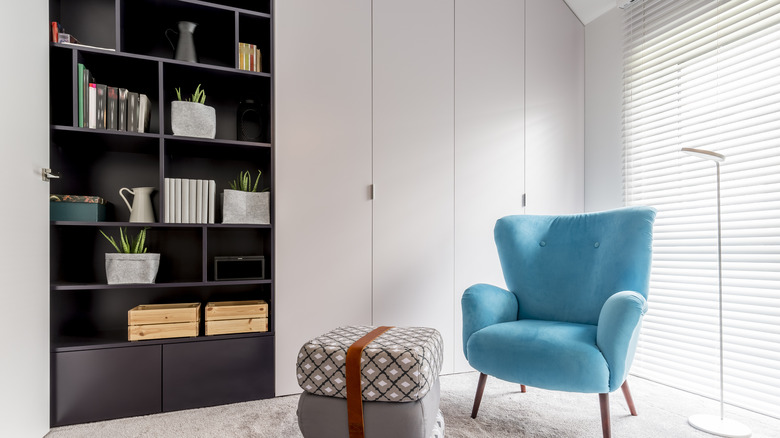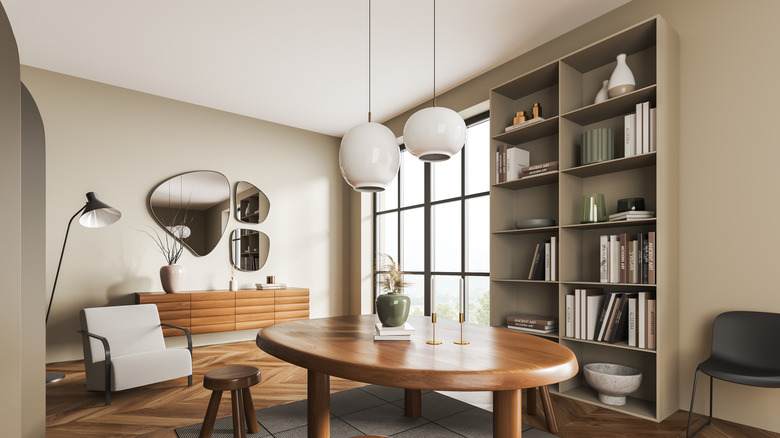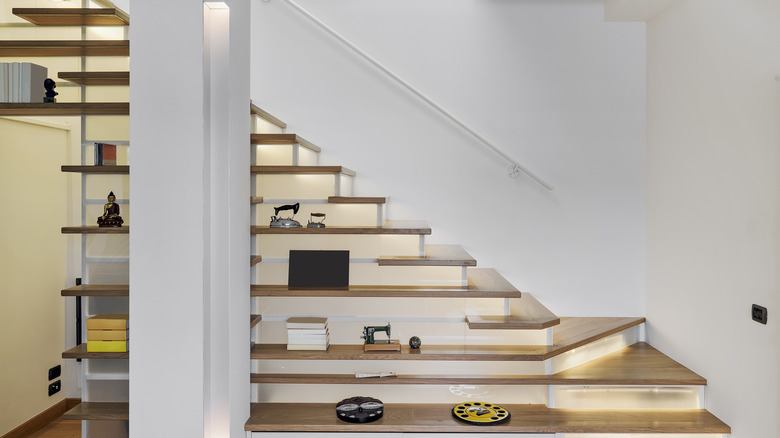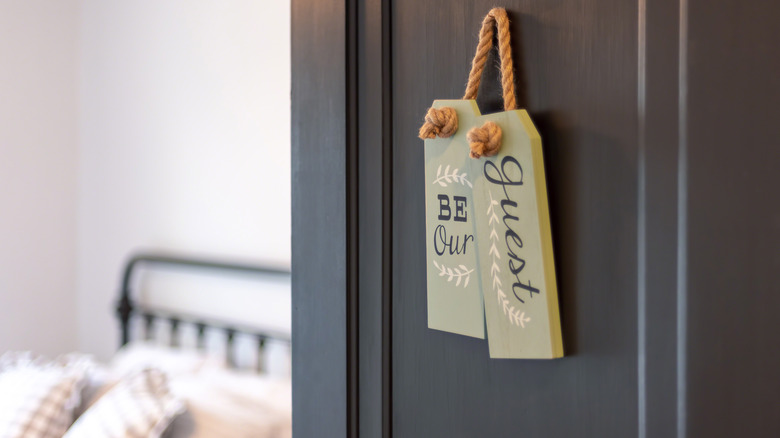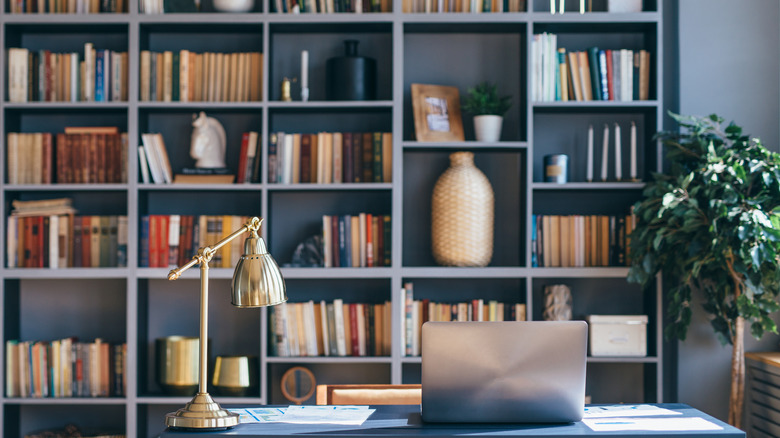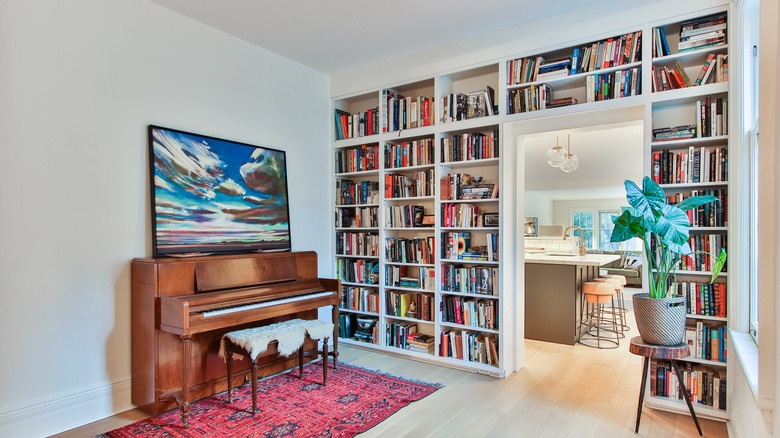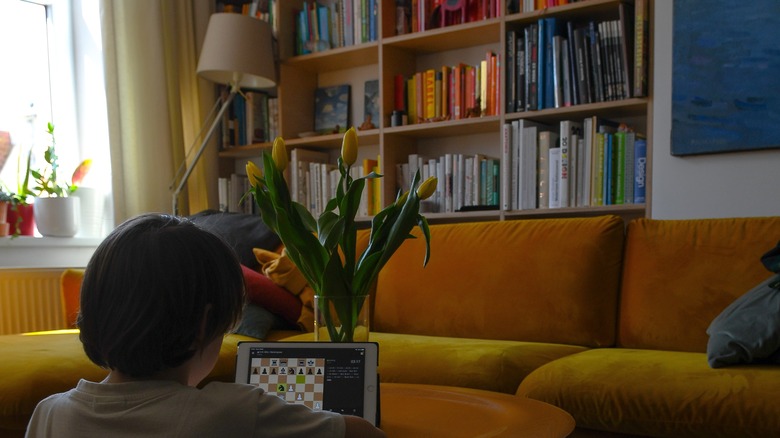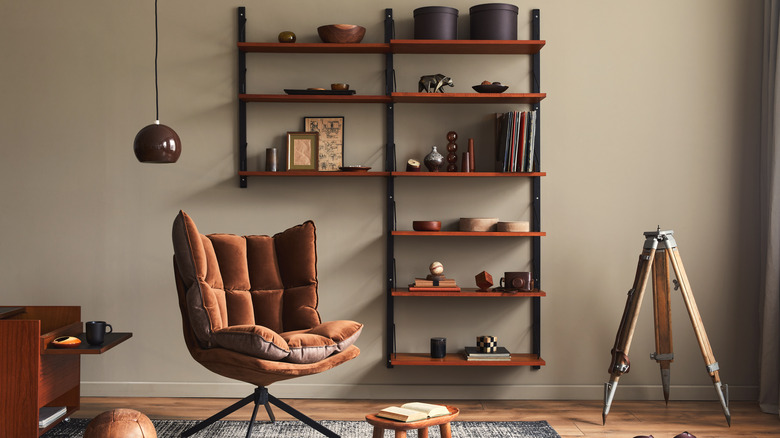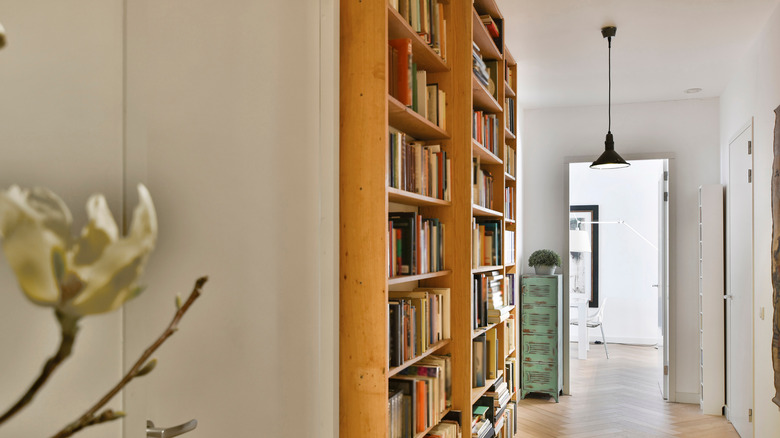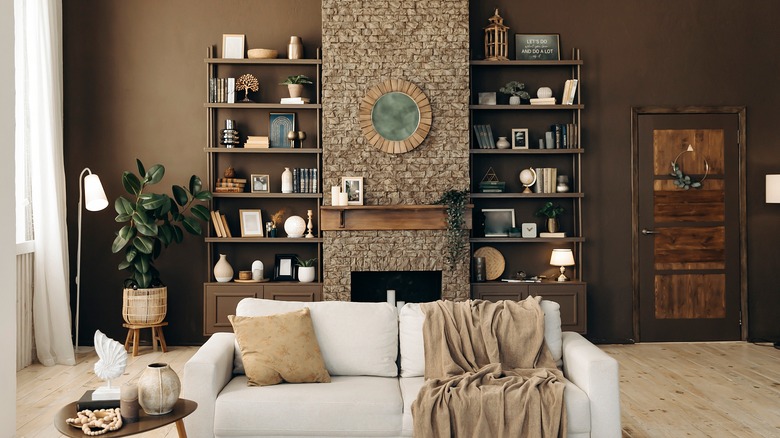How To Transform Any Room With A Custom Designed Built-In Bookcase
Building a custom bookcase is not only a stylish and functional storage solution in any home, but building one is also a beginner-friendly project, according to Home Depot. A beloved home feature, these types of built-ins are capable of transforming any space into something unique and provide an added edge in designing a home. If there's an odd little corner you're trying to utilize or if you're desperate to get some floor space back, a built-in bookcase is a great space-saver and decor element.
One of the greatest appeals of built-in bookcases is how customized they can make a home look and feel (via Julie Blanner). Because they are built flush against a wall they can give you a deep area to work with without taking up a huge footprint. This makes them easy to place practically anywhere in the home that has extended or protruding walls with ease. Any designer, not to mention any real estate expert, can also tell you the added benefits these additions can have on your home (via HomeLight).
Plus, because built-ins are an integrated, custom feature, they can make a space feel more purposely designed (via Christopher Scott Cabinetry and Design). If these projects intrigue you, or if you're looking to update unused space in the home, there are several great ways to do so. There are even some creative and unorthodox ways you can make a built-in bookcase work for the unique needs of your space.
Extend your cabinet space in the dining room with built-in shelves
A potential design solution in which built-in bookcases are used is extending your cabinet space from the kitchen into the dining room. These styles of built-ins, as we've noted, work great in a variety of spaces, meaning they can be used in the dining room no matter the layout or size. Particularly in a small dining room, these shelves can help house extra dishes and silverware, even heirlooms or special occasion items (via Lindsey Putzier Design Studio). This helps alleviate some space in the kitchen for more frequently used everyday items.
However, a more fun design choice is to style these shelves with decorative accents or attractive dishware and serving pieces that would normally be hidden away. As Studio DIY demonstrates, a set of floor-to-ceiling bookshelves can not only help freshen up the style of a dining room but can give you an opportunity to add splashes of color. The integrated look draws the eye upward as well, adding tons of visual interest. For connected areas, such as kitchens with eat-in nooks, these bookshelves can save space and create useful storage. And, by using ones that have a similar color and style as the kitchen cabinetry, you can continue the aesthetic and make the whole room feel more complete.
Utilize wasted space under staircases or railings with built-in shelves
Another main reason to incorporate built-in bookcases is to save on space as opposed to buying furniture to store or display home items or decor. "In today's market, storage is paramount to buyers," John Kostrey, a broker associate with Nourmand and Associates, tells Realtor.com. He adds, "That makes the placement of built-ins, and the amount of storage they offer, even more important than before."
This being said, any unused or oddly shaped spaces in the home that could be potentially useful are great places to incorporate built-in bookcases and shelving. Patrick A. Finn points out that these nooks and crannies can be found all over a home, from the unused space underneath stairways, in the slope of a second-story bedroom wall, or in a nook next to the fireplace. These spaces may not be suitable for habitation but are indeed great areas for storage and displaying decor or books. Not only will adding these built-ins give these spaces purpose, but relocating items here can also free up other previously used storage space.
Make use of built in bookcases in the guest room, either for function or style
If you're not ready to commit to a built-in bookcase in the main living areas, a great way to incorporate this project is within a bedroom, particularly in the guest room. This allows you to try out the technique in a space that isn't used daily. Plus, house guests always appreciate a little extra storage to use during their stay.
Guest rooms can benefit from these types of built-in units because of their purpose within the home itself. As Ulta Home points out, these rooms are often used for additional storage for items that might not have a permanent place in the main living areas. Why not utilize this space more intentionally and give guests something interesting to look at? These units can store unused items like extra books and blankets. They can also be used to display photos or memorabilia like vacation souvenirs. Guest rooms are also naturally a great flex space and can be used for multiple purposes. Additional shelving can be useful to organize the space so it's more functional as an office, gym, or craft room when you don't have visitors.
Give your living area a study-like atmosphere
If you desire a library or office but just don't have the space to devote an entire room to it, make your living areas feel more studious by incorporating built-in bookcases. These elements give some visual and architectural interest, as well as provide the perfect place for storing and displaying books to pull off the library look. There are, however, even more ways you can transform this study corner to further give the illusion of an office or a library.
You can also use built-ins to designate a section of the room, or your house, as the official study area. According to Maryville University, there are many ways to make a space a great place to study. It's important to remove distractions and clutter as well as keep the area organized. Your bookcases can help you achieve these goals, with practical storage and motivating displays. Jennifer Morrell of An Inspiring Home suggests adding cabinet doors on lower shelves of bookcases to provide more functional, tucked-away storage.
Border your doorway with built-ins to add architectural interest
More recently-built properties are often lacking the character and architectural details of older homes. Adding bookshelves around doorways or windows can infuse your home with custom charm. This also transforms otherwise unused space around these frames into functional storage space.
As Café Design points out, these built-in shelves add personalization to your space. This is a great way to highlight your favorite architectural details within your home. Maybe you have a stunning bay window with a built-in seat. Framing it with custom built-in shelves adds function and makes an interesting, one-of-a-kind statement.
Framing windows and doorways with shelves is a versatile option that can work in a variety of spaces. Outline your child's bedroom window with shelving to make the perfect perch for their favorite toys and books. Frame the doorframe of your living room to distinguish it from the kitchen or dining area. Or, utilize the spaces on the sides of windows or doors in bathrooms for much-needed extra storage.
Added decor and storage space in kid's room/playroom
When designing a children's bedroom or playroom, it's best to think about who will use the space most. Katie Thomas, the founder of interior design company KTM Design, tells IdealHome, "First and foremost, design the space for children — not adults. Play with patterns, colors, and textures — children learn by observing and exploring their surroundings...Create a focal point and revolve your design around it."
A great way to incorporate these design choices is to add built-in bookcases, which help increase space from the floors to the ceiling. One key benefit of these design features is their customization. They can work well to meet your space requirements and allow your children to express their creative sides. You can also add fun and colorful wallpaper to the back of the bookcases to make a unique, complimentary statement.
These bookcases are also a great idea to help kids learn to organize, with lots of open space for whatever they like to keep within reach. To give easy access to younger kids, you can stack books in fun color-coordinated arrangements and add baskets and bins to keep smaller items neat and tidy. For older children, built-in bookcases are great to designate a room's homework area, with a desk or study chair in the corner.
Spruce up areas near windows with a reading nook
Large windows are great focal points in your living areas, as well as wonderful for providing lots of natural light. The best way to expand upon this unique design feature is to add some personality and creativity. For bedrooms or well-lit areas with large windows, you can create transform an unused corner space into a reading nook by adding built-in bookcases. These will satisfy the avid readers in your home, as well as those who just like a quiet spot with lots of natural light. The walls near these big windows are perfect places to add built-in bookcases. One idea is to arrange these shelves on asymmetrical walls, according to Annie Elliott Design, to balance the features of the rest of the room and bring in visually stronger focal points, as well as a sense of order.
Keep in mind, if you'd like to use your reading oasis both day and night, effective lighting is key (via Andrew Flesher Interiors). A wall-mounted sconce, ceiling fixture, or decorative lamp can allow for better reading after dark. Don't forget to include comfortable furniture to create a perfect spot for curling up with a book.
Upgrade your hallways with built-shelves for added use and decor
Built-in bookcases are perfect for freshening up spaces in the home that are often a challenge to style. Hallways are areas that can be notoriously difficult to decorate because of their narrow size. Bookcases are proven to be great space savers and placing them in hallways can be a welcome design element that can give your hallway character on top of its functionality. As SmallSpacePros points out, hallway bookshelves and immensely popular. Not only do they provide additional storage space, but they give you a prime opportunity to show off your favorite possessions to those passing through.
However, it's important to be mindful when selecting the size of these hallway bookshelves. Ideally, you want to leave at least a 36-inch wide path for walking through the hallway. Design is also a key consideration, especially in high-traffic areas. Petra Arko, interior designer and founder of Bergman and Mar, tells Livingetc, "My top tip would be to try and find a shelving idea that has rounded corners so that if anyone does happen to brush passed too closely, it's not an issue. Also, just make sure it's thoroughly secured to the wall. Some hallways can be busy spaces, particularly family homes, so making sure it's petite but robust, is a must!"
Surround your fireplace with built-ins to extend mantel decorations
The fireplace is a natural focal point of the home for both its purpose and design. Everyone loves gathering around a fire, and it's a good idea to make the space surrounding the fireplace both eye-catching and comfortable. A great way to elevate the fireplace is to surround its edges with built-in bookcases. The mantel of a fireplace is already a great unique space to add a personal touch. Built-in bookcases are essentially an expanded mantel and can help transform this living space.
The style of both the room and fireplace play a key role in how to decorate the bookshelves around a fireplace — sometimes even the entire home. Items like built-in bookcases can add character and visually interesting elements to an otherwise sterile space. Christine Tuttle, Boston area interior designer, tells HomeLight, "In a big, boxy room that lacks ceiling molding or other details, a bookcase — or a pair of them flanking a fireplace or a media zone — can help create a focal point and give the room structure."
Surrounding built-in bookcases can also help tie in your own personal style. Thoughtfully arranged books can show a love for reading, while souvenirs and framed photos highlight the importance of family. For a simple, classic look, you can add greenery, such as faux or real plants, as well as glossy finished pieces that catch the light of the fire.
